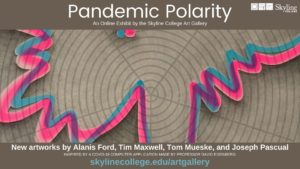 Artists Engage with and Challenge the Times
Artists Engage with and Challenge the Times
Throughout history artists have engaged with, challenged, and tried to make sense of the world around them through the art making process. We can see this through artworks like Guernica by Picasso, which protested the bombing of the Basque village of Guernica by Nazi Germany and Fascist Italy at the request of Spanish Nationalists; and the 1970’s art installation The Dinner Party by Judy Chicago, widely regarded as the first epic feminist artwork. The power of these works transcends their time, as shown in 2003 when the U.N. draped a curtain over a reproduction of Guernica when debating the Iraq War.
Artistic expression is at the foundation of who we are as a global community. It has the power to transcend and transform.
In Pandemic Polarity we asked 4 artists from Barbados (Alanis Ford), California (Joseph Pascual), Iowa (Tom Mueske), and New York (Tim Maxwell), to re-contextualize Corona Virus data through their art in the midst of a worldwide pandemic exacerbated by political divide and climate change.
“Pandemic Polarity brings the intellectual, creative, and social impact of art into our collective reckoning with the COVID-19 pandemic. This thought-provoking exhibition highlights the power of inter-disciplinary collaboration, while illuminating the insights that emerge when we reframe our personal connections to human tragedy, utilizing an artistic lens to interrogate and reimagine our world” -Danni Redding Lapuz, Dean Social Science/Creative Arts Division.
Combining Art and Science
The COVID-19 Polar Graph Export used for these projects is a web application designed and built by early Apple employee David Eisenberg. It takes real-time data from USA Facts and turns them into a polar graph. Polar graphs are graphs created using polar coordinates (measuring distance from the center) rather than the X and Y axis coordinates used in Cartesian graphs.
Eisenberg’s application allows artists to export these polar graphs as vector line art for use in the art making process. Eisenberg chose the Polar Graph for his export program as a way to attract attention with something more visually appealing than bar and line charts.
In a time when art is seen as unessential and science is constantly in question, Pandemic Polarity combines the two to show what is possible when there is a cross-section of science and art.
Along with enjoying the amazing art, and the interview with Barbadian artist Alanis Forde, take a few minutes to view the videos about Polar Graphs and David Eisenberg included in the Pandemic Polarity Exhibit, you will not be disappointed.
The Artists
Alanis Forde (Barbados)
Alanis Forde works mainly with oil paint and collage. Her concepts are based primarily on the black female identity in an idealized, exotic, paradisiacal Caribbean space. Through her proxy she navigates life through paradise.
“An epidemic has erupted throughout the paradisiacal landscapes. . . Paradise is no longer an escape from reality. Everywhere has been affected. What will the world she live in look like in the future?”
Tim Maxwell (New York)
Each of Tim Maxwell’s drawings is sketched out in pencil, then laboriously drawn using unruled lines. Each of these architectural “constructs” is the result of the implementation of geometry in which most start with a very simple vanishing point that is multiplied as the drawing recedes to create an unsettling and alienating atmosphere.
“Initially, I was completely perplexed how to integrate my style into two points. Then, after breaking things down into their essence, the chart became my friend and the process unraveled naturally.”
Tom Mueske (Iowa)
Tom Mueske’s work began as ink on paper, and now includes mixed media on canvas. He graduated from the San Francisco Art Institute with an MFA in 2007 and has exhibited throughout the United States.
“I don’t consider myself an abstract artist—I illustrate abstraction.”
Joseph Pascual (California)
Recent Skyline College graduate Joseph Pascual’s work explores Bay Area Filipino heritage through the art of portraiture. His sculptures are exaggerated three dimensional contours of his subject’s auras with gouache paintings of the actual subject inside them.
“I find motivation in the people around me and for this reason the subjects I work with are mostly Bay Area natives. By painting them and embellishing them with halos, I am glorifying what some would call the ordinary, but I call it life.”
Skyline College Art Gallery
Skyline College’s Art Gallery is an artistic venue with programming that reflects the cultural diversity of the Skyline College community.
Pandemic Polarity is the gallery’s first online exhibit.
Article by Chris Burwell-Woo






